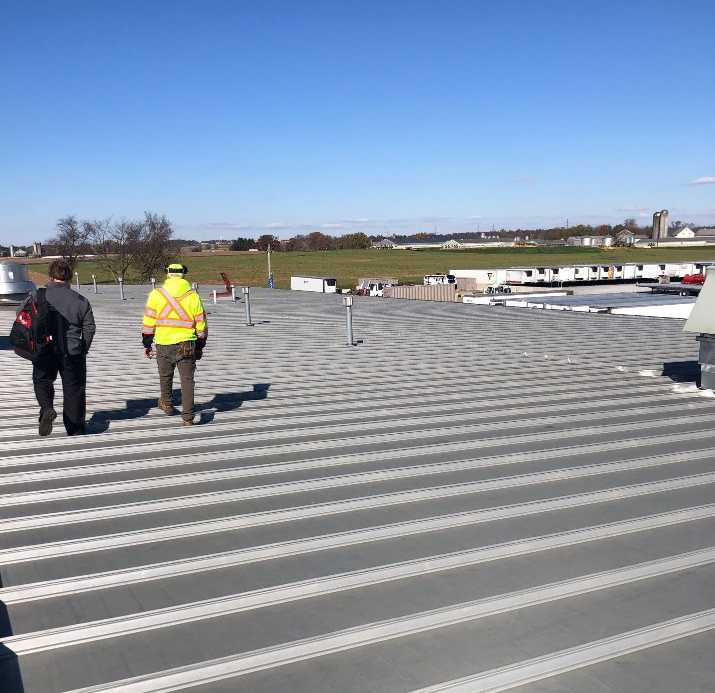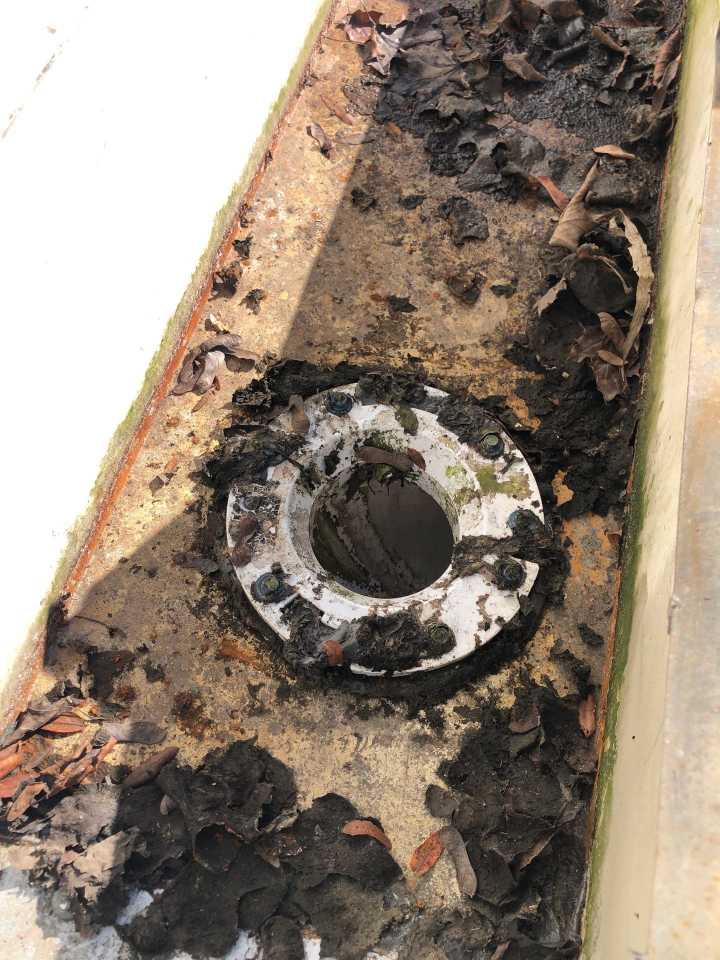- By admin
- Uncategorized
- 0 Comment
How to Ensure Your Commercial Roof Is Ready for Winter
As a responsible property owner or manager, it’s crucial to ensure that your commercial roof is well-prepared for the challenges of winter. Winter weather can be harsh and unforgiving which makes it easily the hardest weather on your roof. Neglecting your roof’s maintenance can lead to costly repairs and disruptions to your business operations. In this comprehensive guide, we will walk you through the essential steps to make sure your commercial roof is ready to withstand the winter season.
Expansion and Contraction of Your Roofing Member During Winter
Buildings located in regions characterized by dramatic temperature fluctuations are always susceptible to roof damage due to the phenomenon of expansion and contraction.
During the winter season, roofs experience a predictable cycle of expansion and contraction. In warmer daylight temperatures, the roof membrane expands, only to contract during the freezing nighttime hours. This minute (but constant) expansion and contraction can result in cracks, membrane shrinkage, and stress on the roof’s seams (among other things).
Moreover, this “thermal shock,” so to speak takes a toll on the roof’s overall tensile strength, significantly reducing it as a consequence of repeated expansion and contractions. As time passes, the roof membrane gradually loses its ability to effectively expand and contract.
This phenomenon affects different roofing materials in an inequitable manner. Black rubber roofs, for example, conduct heat much greater than other roofing membranes such as TPO or PVC. You can have a situation where it’s only 20 degrees fahrenheit in the winter, but direct sunlight hitting a black rubber roof can quickly escalate the rubber’s temperature up to 80 degrees! It’s these temperature swings in the winter that can make the heat fluctuations on roofing systems so profound.

Semiannual, on-site inspections by professional roofing contractors is crucial for making sure your roof is ready for the winter elements
Roof Inspection and Prep
The first and most crucial step in preparing your commercial roof for winter is a thorough inspection in the fall season. It’s recommended to hire a professional roofing contractor with experience in commercial roofing to conduct this inspection. They will look for any signs of damage or wear and tear that may have developed over time. Key areas would include your roof membrane, flashings, as well as drains and gutters.
Remove Debris from Gutters and Drains
The big concern regarding both pitched and flat roofs is that drains are an extremely important factor in maintaining a roof during winter. Gutters and drains simply have to be clear in the winter. ‘Ice damming’ is a term used in the roofing industry and is the result of snow or ice melting and then freezing back over as it gets to the gutters. This effect is especially problematic on residential/pitched roofs when the melted snow or ice flows into the gutters and then refreezes. The refrozen ice then has the ability to infiltrate underneath the roofing membrane, shingles or other various sections of a roofing system. If your drains are blocked, the water will refreeze again, so as with any season it’s especially important to keep those drains clear!
Roof Membrane
Before you head into winter, make sure your preventative maintenance plan not only clears any debris out of the gutters, but also includes a membrane check. A thorough inspection of any small tears or pinholes need to be addressed. The tiny pinholes that weren’t a big deal in a rain storm previously should absolutely be addressed before heading into winter. In the winter, 2 or 4 inches of snow just sitting there – slowly melting or simply sitting and going nowhere – can enlarge the pinholes quickly and create a much larger problem than what you would expect in the warmer months.
Ultimately, those little problems on your roof that weren’t that big of a problem during a rainstorm can become a very big deal when ice and snow are sitting on your roof for days and weeks on end. So from an emergency standpoint and a preventative measure it’s important to address any issues with your roof’s membrane prior to the winter months.

Clear drains and gutters before winter comes around to avoid ice damming and debris buildup
Insulation and Ventilation
Proper insulation and ventilation are essential for maintaining a comfortable and energy-efficient interior during the winter months. Inadequate insulation can lead to heat loss and (as mentioned earlier) ice dam formation, which can penetrate and further exacerbate tiny pinholes and membrane tears. Ensure that your roof is adequately insulated and ventilated to prevent these issues.
Flat Vs Pitched Roofs in the Winter
When it comes to winter, ice and snow can be rough on any roof. Flat roofs are unique in that they will hold the snow and ice for extended periods of time, whereas sloped roofs will melt the precipitation faster due to being pitched away. This is due to the effect of the melting water moving down along the pitched roof which has the effect of quickening the melting time of the snow or ice it’s rolling through. The strategy for protecting a pitched roof is both the same and in some aspects different when it comes to protecting a flat roof during winter.
Removing Snow from a Pitched Roof
If you’re working with a pitched roof, you usually don’t need to physically shovel off the snow most of the time. Most pitched roofs in the northeast are designed to withstand average amounts of snowfall weight in the region. The only time you should address snow and ice on a pitched roof is when you have multiple roof layers on your building.
In some situations, a roofer will install a new roof without tearing off the initial layer (certain municipalities allow two layers of roofing). The issue with this extra layer of roofing is that, well… it’s an extra layer of roofing, and that means twice the weight! So if you have two layers of roof on the building and you add 10 inches of snow on top, you may be in a situation where it would be appropriate to shovel off that snow.
Removing Snow from a Flat Roof
If you’re in a flat-roofed commercial building, you really should have a snow removal plan in place. The plan should specifically be attentive to the drains in and around the flat roofing system, as most of the drains are sunk down in a flat roof. This is in contrast to drains on a pitched roof which are pitched down to gutters and gutters to downspouts. Flatroof drains sunk into the roof can create a situation where that 8 inches of snow you had last week sort of just sits there, melting and refreezing again and again.
The issue with removing snow from a flat roof is that it can be a delicate procedure in that a membrane roof can easily be punctured by a snow shovel. The last thing you want is to send an inexperienced maintenance worker up on the roof to hack away on the snow and ice. Personally at J Smucker Contracting, we get calls every year from inadvertent shovel slices that punctured roofing membranes.
Additional situations that may arise would be when you need to access the HVAC systems on a flat roof during the winter. Path’s may need to be created after a snowstorm so consideration there is warranted. Having a professional roofing contractor that can expertly clear a flat roof of snow and ice without damaging the membrane is highly preferable to the alternative.
If you have to shovel the flat roof yourself the key thing to remember is that the goal is not to shovel the roof clean like you would on a sidewalk or driveway. The goal is to get most of the snow off while leaving a small portion left which will allow for proper drainage. Additionally, remember to use a plastic shovel as opposed to a metal one to avoid any detrimental contact with the membrane. It deserves to be repeated; the main goal after a snow storm is clearing out the drains and removing most of the snow.
How to Organize A Preventative Maintenance Plan
As stated previously the goal of a preventative maintenance plan is to have a roofing professional preparing and inspecting the roof before winter comes around. That’s why most semi-annual maintenance plans always have on-site inspections in the spring and then again in the fall. Fall is the time to get up there and batten down the hatches! Your fall preventative maintenance plan should look for leaks, seal around seams and penetrations, any areas around the flashings and generally make sure your roof is as water-tight as can be.
To organize the plan, simply contact an established commercial roofing contractor before winter comes around, preferably in the summer to early fall months, and get r’ done!
Conclusion
Winter is the hardest month on your roof. Ensuring that your commercial roof is ready for winter is a critical responsibility for property owners and managers. Regular inspections, timely repairs, proper insulation, and a well-thought out snow removal plan are key components of effective winter roof maintenance. By following these guidelines, you can protect your investment, prevent costly repairs, and keep your business operations running smoothly throughout the winter season
Need Help Winterizing Your Commercial Roof in Lancaster, PA?
Remember, a well-maintained roof not only safeguards your property but also contributes to energy efficiency and a comfortable indoor environment. Don’t overlook the importance of winter roof preparation, as it can make a significant difference in the long-term health of your commercial building.
If you would like more information about a tailor-made winter weatherization plan for your commercial property, please reach out to the commercial roofing experts at J Smucker Contracting. We’ll assist you in extending the lifespan of your commercial roof with trustworthy inspection and maintenance plans. Give us a call today!

